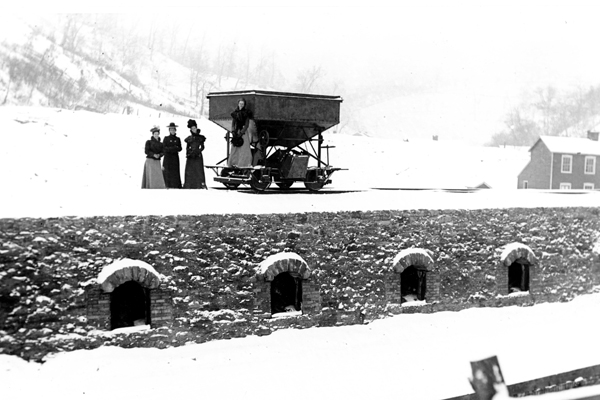This segment features a news item from Fayette County’s past. This week we examine a story from the January 28, 1915 edition of the Morning Herald.
In January of 1915, the U.S. was just emerging from a two-year recession. It was in this economic climate that the The Morning Herald made a joyful announcement: The H.C. Frick Company had called for a thousand more coke ovens to be fired (or put into operation) across the region, and ordered them to run five days a week.
In case you’re not familiar with the terminology, “coke” is a silvery, porous fuel derived from coal that is used in iron and steel-making. It was once produced in “beehive ovens,” which got their name from their domed, hive-like shape and remain a part of the landscape in Fayette County to this day. Coke production was linked directly to mining; in fact, most coal operations around these parts had beehive ovens on-site. A single operation might have hundreds of these ovens or only a few, as in the case of the Daugherty Mine & Coke Works (or “Big Six,” for its six ovens).
The firing of a thousand ovens was a development that, by the Herald’s estimation, would provide jobs for hundreds of otherwise idle coke workers:
“The news is the most joyful that has reached this district in many months, not only to the coke worker, but to the united population as well. It means that every business of the district will benefit and it is predicted that before spring is very far advanced Fayette Countians will have forgotten the present business depression.”
A major factor in the rising demand for coke was a five-percent raise in freight rates that was approved by the Interstate Commerce Commission. This, in turn, encouraged an uptick in train traffic, and the railroads began to request more “steel rails, steel cars, and other . . . steel accessories.” With its close ties to the steel industry, the H.C. Frick Company doubtlessly anticipated the growing demand within the U.S.
There was another factor that contributed to the coke boom, however: “millions of dollars worth of orders from foreign countries.”

Women posing on a battery of (non-functioning) coke ovens.
The piece of machinery on top is a lorry, used for transporting coal to the ovens.
Credit: Uniontown Public Library.
Just six months before the story ran in The Morning Herald, World War I had started in Europe, and products from the still-neutral U.S. were finding their way to the combatants. The link between conflict and our local industries was unfortunate but very real. After the Great Depression — a time when some were forced to seek shelter in the inactive beehive ovens — the onset of World War II gave the coal, coke, and steel producers a similar boost.
The sinking of the Lusitania and loss of 1,192 passengers in May of 1915 marked a shift in public opinion on the war. At first the U.S. and U.K. adamantly denied that the ship was carrying war materials. Much later, the release of the ship’s full manifest revealed that munitions were on board — including shrapnel and fuses courtesy of Pennsylvania’s Bethlehem Steel.
![]()









